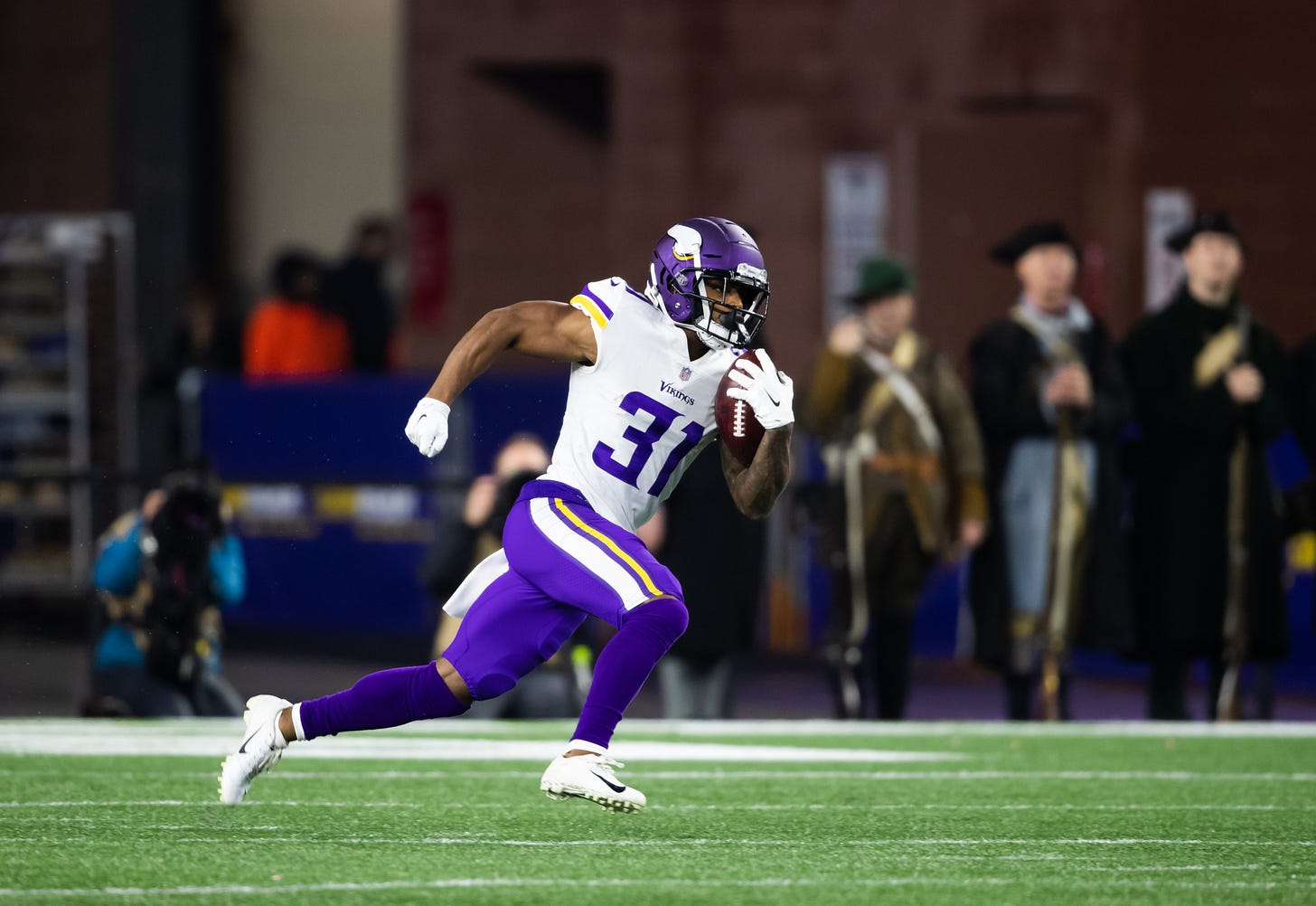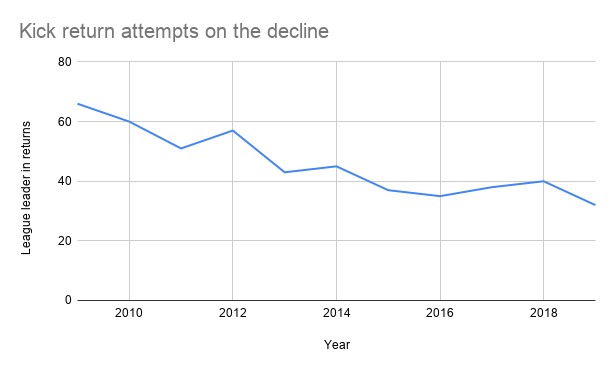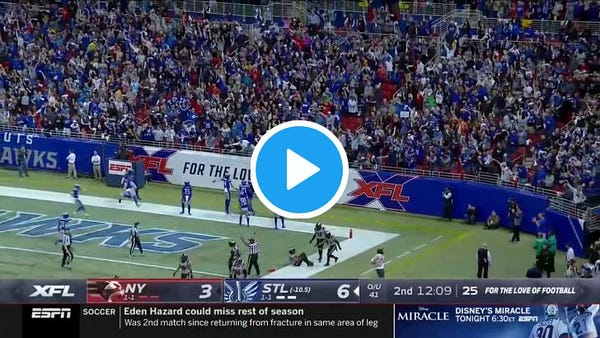Why the Vikings should root for the XFL's kickoff rules
The great kick returners are gone with current rules. It's time to change that

*Photo courtesy of the Minnesota Vikings*
Welcome to Purple Insider: A daily newsletter covering everything Minnesota Vikings by Matthew Coller. With credentialed access combined with a creative and fun approach, my goal is to keep you informed and entertained. Please subscribe if you’d like to read more!
Every kick return that has ever been taken back for a touchdown has a moment where the entire building realizes the returner going all the way. He finds a hole, the crowd crescendos and he’s off to the races. Instant game-changer.
Few plays in sports compare to a touchdown return’s jolt of energy and no fan base understands it better than that of the Minnesota Vikings. Thanks to Percy Harvin and Cordarrelle Patterson, the Vikings have the most (10) kick returns for touchdown since 2009, three ahead of the next best team (Baltimore).
But the opportunities for that instant injection of offense have all but disappeared with the NFL’s current kick return rules.
Last year the NFL’s leader in kick return attempts had just 32 and the entire league totaled seven returns for touchdown. In 2009, the league leader had 66 and the NFL produced 18 awe-inspiring returns for a score.
The 2019 season saw the leader in attempts have the fewest returns since the NFL began tracking return statistics.

The decline of the kickoff return hasn’t just extracted a fun play from football, it’s taken away a tradition of specialty players who become fan favorites like your Dante Halls, Mel Grays, Eric Metcalfs, Josh Cribbses and it’s left a black hole in that space. For fans, all kickoffs mean now is they have time for a trip to the fridge.
But this spring, in its brief return before the COVID-19 pandemic brought the league’s second stint to an end, the XFL offered a solution in the form of a unique return structure that saw 93% of kicks returned while vastly increasing the safety of the play.
The start-up league offered a model for the NFL to bring excitement back to the game’s opening play without sacrificing measures to protect players.
How the XFL kickoff came to be
You might have heard of XFL commissioner Oliver Luck’s son Andrew. Stanford kid, pretty good NFL quarterback. Well, Andrew’s center during his college years was Sam Schwartzstein, a team captain with the nickname “Coach Sammy” because of his ability to decipher defenses at the line of scrimmage. After his playing days at Stanford came to an end, Schwartzstein did as one does in Northern California: He began a career in the tech world of Silicon Valley.
So when Oliver Luck was tabbed as the XFL’s leader, he brought along the former Stanford captain to develop XFL rules.
“Everything we did in Silicon Valley was: What problem are we trying to solve?” Schwartzstein said over the phone. “Defining that problem with success metrics. What does success look like? And in the grand scheme of things, what is the market telling us about the problems that we're solving. It gave us an approach that was a little bit different than just saying, 'I want to fix [kickoffs] or why don't we have kickoffs anymore?’”
Two years before the XFL booted its first kickoff, the quickly-defunct Alliance of American Football also understood there was a problem with kickoffs that needed solving. Their solution was to eliminate it entirely and start every offensive possession at the 25-yard line. Schwartzstein and the XFL saw that as short-sighted. Why take away something exciting simply because you can’t figure out a better way?
Luck asked his new rule maker: What does the kickoff look like at the moment the receiving team catches the ball?
“I watched over 100 clips of film and paused the film when the ball is caught and the plays are 3-7 yards apart facing each other almost 100% of the time,” Schwartzstein said. “We said, let's just start the play there.”
That’s exactly what they did. Here are the rules they landed on:
The kicker kicks from the 30-yard line and must kick the ball in the air and in play between the opponent’s 20-yard line and the end zone.
The coverage team lines up on the return side 35-yard line and the return team lines up on the 30-yard line. Each team must have exactly 3 players outside the hash marks on both sides of the ball and cannot move until the ball is caught by the returner.
Naturally there was skepticism.
A broadcaster commented to Schwartzstein that the league needed to be ready to switch to an NFL-style kickoff in case their newfangled plan flopped. A friend of his was unhappy with teams no longer having the option to surprise opponents with an onside kick. And XFL coaches, well, they were “scared sh—less” of having to figure out an entirely new strategy.
“The best coaches are the ones who saw it as an opportunity for greatness, an opportunity to do something unique,” Schwartzstein said. “We had eight testing sessions. We tested a throw back, double reverses, we had a lot of stuff there that we were able to give our coaches to practice. Some coaches said they were just going to run base stuff and just have their guys block it well but the coaches who approached it for uniqueness took that film and said: Let's try something exciting.”
After a few weeks, something exciting is exactly what happened.
“What we saw was a reverse touchdown, we saw a return on a fake reverse, we saw a touchdown on a cross blocking scheme,” Schwartzstein said. “The way we started looking at it was like a giant offensive line play. Inside zone, outsize zone, reverse, cross blocking, trap, all these different things that made the play exciting. Fans may not see those intricacies but it was evolving week to week.”
By the time the league was shut down, teams’ average starting position was higher than the NFL, they had returns on nearly every play and the once scared sh—less coaches came to appreciate the XFL’s effort.
“At first some XFL people were like, ‘I don’t know about this,’ but by the end they all loved it,” said ESPN reporter Kevin Seifert, who covered the XFL this spring, said.
Returners of the NFL’s kickoff heyday also took notice.
“It was genius by whoever invented it,” former Viking Qadry Ismail said. “The way XFL players executed it was cool and I really enjoyed it. I think it can work big time in the NFL.”
Another former Viking kick returner Moe Williams hadn’t seen it. His response via text when he was sent video of the XFL return: “That’s awesome! There it is, problem solved.”
And on the safety side, Schwartzstein said there were zero concussions reported on kickoffs. When the NFL’s kickoffs were at their height, they made up 21% of all concussions. Recent rule changes have reduced injuries but a big chunk of the drop in concussions is due to nearly eliminating the play.
“To the extent there would be injuries, you wouldn't attribute that to the kickoff because the functional play is not much different than offense and defense,” Seifert said.
Opportunity
Qadry Ismail and Moe Williams became Viking fan favorites in their day. In today’s game, they might have been playing in the XFL instead of the NFL early in their careers because the kick return specialist has gone the way of leather helmets.
“I loved the fact that I came out of Syracuse as a kick returner,” Ismail said. “It got me on the field in college and I became an All-American in college because of it.”
From 1993 to 1998, Ismail had more kick returns than receptions. He made returning into an art form, getting advice from other returners, looking for ways that he could use his eyes and misdirection to set up his blocks and juke defenders.
“It was that sense of setting up the coverage team and your guys are blocking them in a certain direction you can set them up like a running back and then explode through the hole,” Ismail said.
It took until age 29 with the Baltimore Ravens for Ismail to become a top receiving option. In three years with the Ravens, he racked up two 1,000-yard seasons and was second in receptions on the 2000 Super Bowl team.
Williams followed a similar path. His early role in the NFL shows you how much things have changed. He was on the squad as a No. 2 returner who saw between 15-30 kicks per year.
“I believe we dressed about six running backs, which is unheard of, but myself and John Henry Mills and guys like that dressed as special teams players,” Williams said. “It was really only about four guys who were expected to hit the field on offense. But we had a vital role in special teams and it enabled us to be on the field and allowed us to change our lives financially.”
From age 22 to 26, Williams never rushed the ball on offense more than 25 times but opportunity came knocking when injuries eventually opened the door to a regular role on offense. He scored 11 rushing touchdowns in 2002 at age 28 and picked up 1,389 yards from scrimmage the following year.
The XFL had players like Williams and Ismail in mind when they designed their kickoff return.
“We knew we were going to have some standout players as returners who missed the NFL because they couldn't play receiver or other special teams,” Schwartzstein said. “We wanted to highlight those players. That was a huge part of it.”
It’s hard not to wonder how many players missed out on chances to become the next Ismail or Williams because kick returning isn’t a high priority anymore.
Will the XFL come to the NFL?
At the NFL Combine one special teams coach mentioned to Purple Insider that there was some buzz around the XFL kickoff and said he would like to see it in the NFL.
“A couple competition members brought it up unsolicited at the NFL Combine just as, 'What do you think about this XFL thing?' and they brought up the kickoff,” Seifert said. “It was the first thing that caught their eye.”
But there’s a long road between “caught their eye” and happening. Even changes that were implemented in 2018 — which were barely noticeable to onlookers and did not improve the rate of returns — took significant time and debate.
“Whether they would say, 'Let's go ahead and steal this from the XFL,' that wouldn't be in character,” Seifert explained. “They would want it to appear as if it was their own idea so I don't sense any momentum for that….If another season goes by that returns are 30% or 35% and touchbacks are 60% or more maybe they will look at other ways to do it.”
As much as Schwartzstein believes in his product, even he wouldn’t toss it into the NFL without a larger sample size of testing.
“I think if you did it in the preseason or do some more experimenting with other spring games or college football just to make sure it checks out,” he said. “I think it works great. I think it works perfectly. But if I was working for the NFL, I'd want to test it there. Would it be better than what they have right now? Yes.”
So far, however, nobody from the NFL has reached out to the kickoff’s designer about his invention.
“I’d love to talk to more people about it,” Schwartzstein said.
Maybe someday.
Until then Ismail and Williams will be rooting for it.
“Not having kickoffs is an injustice to the game and injustice to the fans...bring it back,” Williams said. “Give teams an opportunity to start games with a game-changer in the beginning.”



Interesting. I didn’t watch any XFL, but find this quite intriguing.
Bonus points for mentioning tecmo super bowl all star Mel Gray.